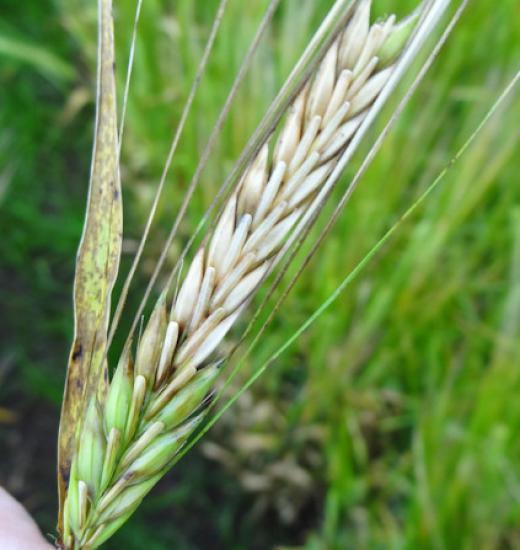SRUC Experts Warn Farmers of High Disease Risk to Spring Barley
14th March 2013

www.sruc.ac.uk/news
Plant pathologists from Scotland’s Rural College (SRUC) are warning Scottish farmers that there is an almost unprecedented disease risk to spring barley this year after the heavy rains last season. After finding that in some regions nearly 50% of the seeds are infected with at least one strain of fungal disease they are stressing that farmers in all regions should get their seeds tested and treated to minimise the risk.
Very high concentrations of fungal diseases such as Fusarium and Microdochium have been found in spring barley seed samples sent in from all over the country. When Dr Fiona Burnett, a plant pathologist with SRUC, decided to carry out an ear blight survey she expected the results to be bad as the risk of blight due to Fusarium increases when there is heavy rain late in the season.
“Our trial fields were decimated,” Dr Burnett says, “and many farmers suffered similar problems in 2012. Due to the bad harvest we are seeing a rise in seed prices which may mean more farmers using their own seeds. However, our tests have shown that it is likely these will be heavily infected. Some samples we tested had two strains of Fusarium and one of Microdochium.”
Tests carried out by SRUC found that in the Edinburgh and Lothians region, where it rained heavily through June and July, 48% of the spring barley seeds were harbouring at least one fungus. While other areas had lower concentrations (41% in the north east) it is clear that these pathogens have taken hold throughout Scotland.
“The risk is high everywhere,” Dr Neil Havis, SRUC plant pathologist, says. “I would strongly advise all farmers to get their seeds treated before they drill. Seed treatments will protect the seedling as it establishes and also reduce inoculum levels in the soil and at the base of the crop. If the crop is infected later in the season, particularly if we have yet more rain, large portions of their barley could be infected with ear blight.”
Dr Burnett adds “We are in uncharted territory as the infection levels are far higher than we normally deal with with seed treatments. It therefore seems prudent to drill seed rates that will allow for some plant losses to seedling blight and we would always advise drilling into a fine, warm seed bed which in current cold conditions is somewhat wishful thinking. The double whammy of cold wet soils, slow emergence and high infection levels on seed could really reduce plant counts.”
Fusarium and Microdochium are fungal diseases that affect cereal crops. Soil and seed borne pathogens, they affect the seeds and are known as ‘damping off’ diseases as the infection can smother and kill off young plants. When it rains the fungal spores can be moved up the plant as the water splashes off the soil and in this way more mature plants become infected with ear blight. Symptoms include a whitening of the grains and a bleaching of the ear. Sometimes the grains become darkened and if spores are being produced the ears can have a pinkish tinge. The disease can cause reduced yields, low specific weights, reduced seed germination and in some case the contamination of the grain with mycotoxins which can be harmful to humans and animals.
While Fusarium and Microdochium can affect all cereals including wheat the area of spring barley this year will be increase due to failures in winter crops.
Many farmers look to sell their barley crops to maltsters for use in brewing beer and distilling whisky. However, barley considered to be infected with Fusarium or Microdochium will usually be rejected as it is believed to damage the quality of the finished product. In beer the fungus is thought to cause ‘gushing’, where an unshaken bottle is opened and the beer suddenly foams up and spills out.
Spring barley seed sample infection by region:
East Scotland/Edinburgh and the Lothians: 42%
West Scotland/Dumfries and Galloway and Lanarkshire: 33%
North Scotland/Aberdeenshire: 41%
South Scotland/Scottish Borders: 32%
Central Scotland/Angus, Tayside and Fife: 42%
---------------------------------------------------------------------------------------------------------------
Barley is the main cereal crop grown in Scotland, and the most valuable. In 2011 we grew 1.8 million tonnes of barley which had a market value of £286 million. In comparison our oat crop was worth just £20 million and our wheat crop £129 million.
The Grampian region grows 40% of Scotland’s barley with Tayside growing 19%.
Spring barley accounts for 82% of the barley grown in Scotland and 43% of the UK’s spring barley is grown here. The price per tonne has risen from £80 in 2009 to £160 in 2011.
Much of Scotland’s barley is used for animal feed (62%) and the cost of feeding animals has risen from £381 million in 2007 to £592 million in 2011.
The figures above were taken from the Economic Report on Scottish Agriculture 2012.
Pictures of affected barley are available. For interviews with Dr Burnett or Dr Havis please get in touch.
SRUC was formed by the merger of Barony, Elmwood and Oatridge Colleges with SAC (Scottish Agricultural College).
